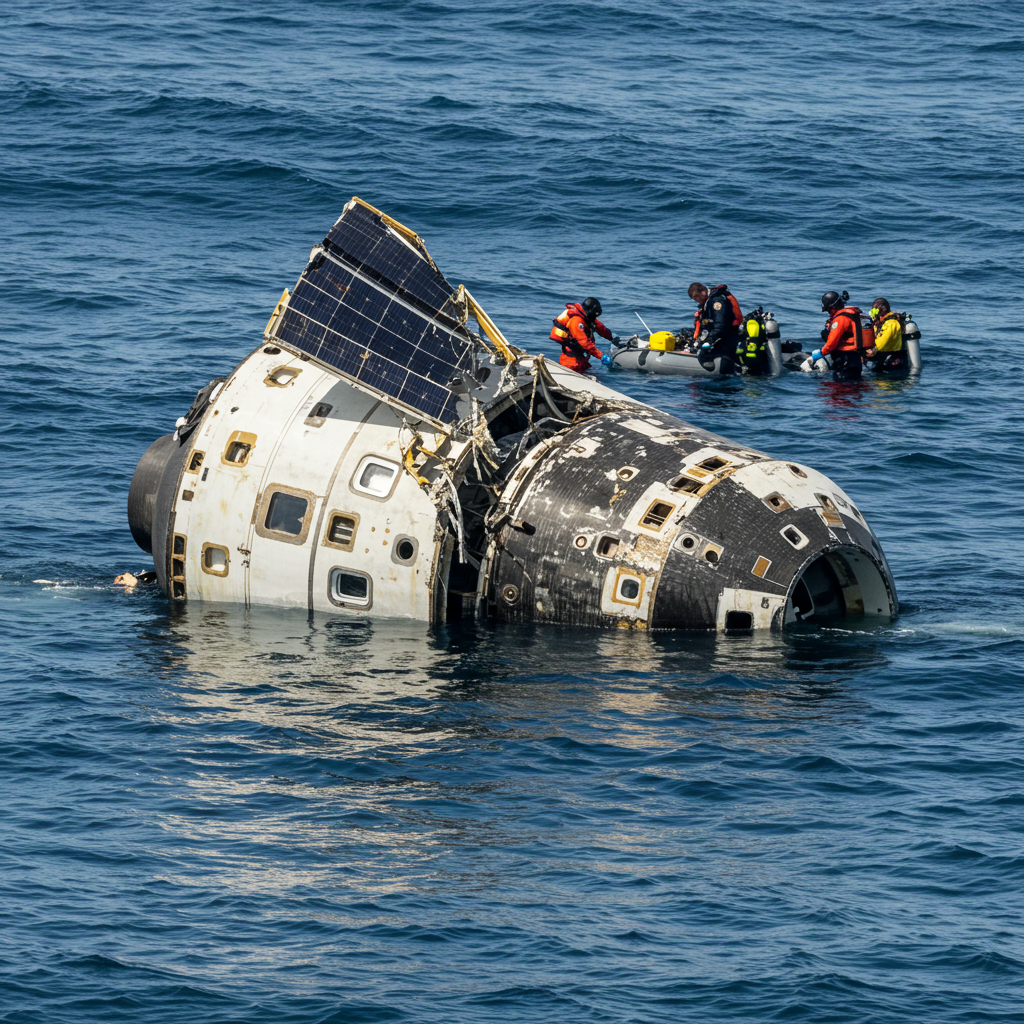A private space mission carrying the remains of over 166 people tragically ended with its capsule crashing into the Pacific Ocean. The incident occurred after the capsule’s parachute system failed during descent, resulting in the loss of all contents. The mission, a partnership between celestis Memorial Spaceflights and The Exploration Company (TEC), aimed to return the precious cargo to families after a journey into orbit.
While the mission achieved several key milestones, the final failure is a significant setback for both companies and a heartbreaking outcome for the families who entrusted their loved ones’ legacies to this flight. The event highlights the inherent risks involved in pushing the boundaries of private space exploration, even as companies strive for innovation and accessibility.
A Mission of Remembrance: The Perseverance Flight
The ill-fated journey was known as the “Perseverance Flight” by Celestis Memorial Spaceflights. This company specializes in providing space memorial services, offering families a unique way to honor their deceased loved ones. Options range from sending remains on suborbital flights to launching them into deep space.
This particular mission utilized Celestis’s “Earth Rise” package. This service involves sending a small amount of cremated remains or DNA into space, orbiting the Earth, and then returning the flight capsule to the families as a keepsake. The Perseverance Flight was the 25th overall space mission for Celestis and their 12th “Earth Rise” attempt designed for return.
For this mission, Celestis partnered with European spacecraft manufacturer The Exploration Company. TEC provided their “Mission Possible” Nyx capsule, which was the primary vehicle for carrying the memorial payloads. This collaboration marked a new type of Earth Rise mission for Celestis, promising participants a spectacular liftoff and recovery experience.
Launch and Journey: Almost as Planned
The mission began successfully on June 23, 2025. The Nyx capsule launched from Vandenberg Space Force Base in California atop a SpaceX Falcon 9 rocket. This launch was part of SpaceX’s Transporter-14 rideshare mission, which carried a total of 70 payloads into orbit for various customers.
The Nyx capsule was the largest payload on the mission. It successfully reached low-Earth orbit as planned. According to The Exploration Company, the capsule performed nominally throughout its time in space. This included powering its customer payloads while in orbit and stabilizing itself after separating from the launch vehicle.
After completing two or three orbits around the Earth, the Nyx capsule began its planned reentry sequence. This phase involved the spacecraft falling back through the Earth’s atmosphere. As spacecraft reenter, intense friction creates a layer of superheated plasma around them. This phenomenon causes a temporary but expected communication blackout period.
The Nyx capsule successfully navigated this challenging phase. It managed to re-establish communication after the blackout period. At this point, the mission seemed on track for its planned splashdown in the Pacific Ocean.
The Final, Fatal Anomaly
The critical failure occurred just minutes before the anticipated splashdown. The Exploration Company reported encountering an issue shortly after re-establishing communications. They lost contact with the capsule at this crucial stage of descent.
The root cause of the failure was later clarified by Celestis. In a statement, Celestis confirmed that “the parachute system failed.” Parachutes are essential for slowing a reentering capsule sufficiently for a soft landing or splashdown, enabling recovery.
Without the parachute deployment, the Nyx capsule plummeted into the Pacific Ocean. Celestis stated that this uncontrolled impact resulted in the “dispersal of its contents at sea.” The capsule and the flight capsules containing the human remains were lost and are believed to be unrecoverable.
More Than Memorials: Other Lost Cargo
The Celestis memorial payload, representing over 166 individuals, was the most poignant loss. However, the Nyx capsule carried approximately 300 kg (660 lbs) of customer payloads in total.
Among the other cargo lost was cannabis plant matter and seeds. These belonged to Martian Grow, an open-source citizen science project. Their objective was to study how microgravity affects the germination and resilience of cannabis. This research aimed to provide insights into growing plants in environments like Mars, viewing cannabis as a suitable test subject due to its resilience.
This loss affects multiple clients and diverse scientific or personal objectives placed aboard the same mission.
Company Responses and Lessons Learned
Both Celestis and The Exploration Company expressed their regret and offered apologies to their affected clients.
Celestis acknowledged the significant personal loss for the families. While accepting that the flight capsules cannot be recovered, they offered a measure of solace. Celestis CEO Charles M. Chafer suggested families might find peace knowing their loved ones were part of a historic journey to space, orbited Earth, and now rest in the vastness of the Pacific. He likened it to a traditional and honored sea scattering. Celestis plans to contact each family individually to offer support and discuss next steps.
The Exploration Company characterized the outcome as a “partial success (partial failure).” They highlighted the technical milestones achieved before the final anomaly. These included successful launch, orbital operations, stabilization, reentry, and initial communication re-establishment. The company acknowledged the inherent risks of innovation and their effort in pushing boundaries rapidly. They are currently investigating the root causes of the parachute failure and plan to share more information soon.
Despite the setback, TEC remains committed to its long-term goals for the Nyx capsule. Nyx is being developed to transport cargo and eventually crew to and from Low Earth Orbit (LEO), potentially serving destinations like the International Space Station (ISS) or future commercial stations. The company stated its intention to “re-fly as soon as possible,” leveraging the lessons learned from this investigation to reduce risk for future flights.
This incident is not the first setback for either company in their pioneering efforts. Celestis previously lost a payload in May 2023 when a rocket carrying remains exploded shortly after liftoff. The Exploration Company’s first demonstrator flight, Mission Bikini in July 2024, also encountered issues, failing to perform reentry due to an upper stage anomaly on the Ariane 6 rocket. These experiences underscore that space development is an iterative process where failures, while costly, provide crucial data for future success.
The Meaning of Space Memorials
For families, sending a loved one’s remains into space carries deep symbolic significance. It connects personal remembrance with humanity’s grand journey of exploration. The Perseverance Flight included poignant stories, such as a three-year-old sending his DNA alongside a symbolic representation of his late grandfather, honoring a shared passion for space.
While the physical recovery of the flight capsules was the intended outcome, the journey itself held meaning. The concept of a “sea scattering” in the vast Pacific, following a journey to the stars, may offer some form of closure for those impacted by this unexpected turn of events.
Space memorial services represent a growing niche in the private spaceflight industry. As access to space expands, so do the possibilities for unique and personal connections to the cosmos. However, this incident serves as a stark reminder that space travel, even for small payloads, remains a high-risk endeavor.
Frequently Asked Questions
What happened to the space capsule carrying human remains?
A space capsule called Nyx, operated by The Exploration Company for Celestis Memorial Spaceflights, crashed into the Pacific Ocean on June 24, 2025. This occurred after its parachute system failed during reentry to Earth’s atmosphere, just minutes before its planned splashdown and recovery.
Why did the Nyx space capsule crash?
According to statements from Celestis, the primary cause of the crash was a failure in the capsule’s parachute system. This prevented the capsule from slowing down properly during its final descent, leading to an uncontrolled impact with the ocean and the loss of its contents. The Exploration Company is currently investigating the specific root causes of this anomaly.
What was lost when the capsule crashed?
The capsule carried approximately 300 kg (660 lbs) of payloads. The most significant contents were flight capsules containing the cremated remains and DNA of over 166 people, sent by Celestis Memorial Spaceflights. Other lost cargo included cannabis plant matter and seeds for a citizen science project studying plant growth in microgravity. All contents were dispersed into the Pacific Ocean and are believed to be unrecoverable.
Conclusion
The loss of the Nyx capsule and its precious cargo, including the remains of over 166 people, is a somber event in the world of private spaceflight. While the mission achieved important technical steps for The Exploration Company, the failure of the parachute system denied families the intended return of their loved ones’ flight capsules.
The incident underscores the challenges and inherent risks of developing new space technologies. Both Celestis and TEC have acknowledged the loss and are focusing on understanding what went wrong to inform future missions. For the families affected, the event transitions from a planned recovery to an unexpected sea scattering, linking personal remembrance to the vastness of Earth’s largest ocean. The ongoing investigation and TEC’s commitment to learning from this setback will be crucial for the future of their Nyx program and the evolving landscape of private space services, including memorial flights.




